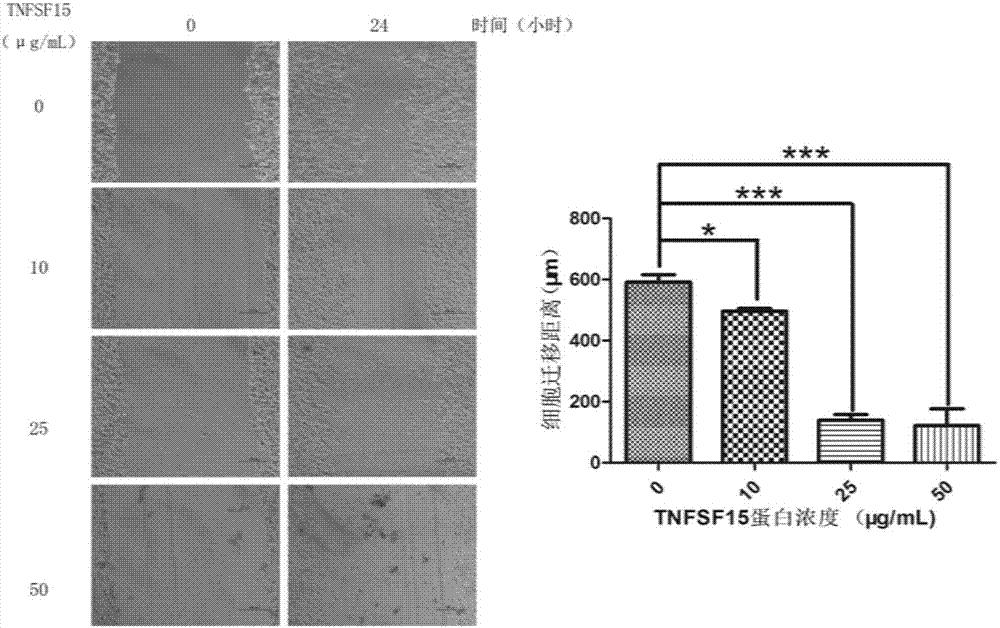Use of TNFSF15 protein in preparation of melanoma treatment medicine
A melanoma and protein technology, applied in the field of medicine, can solve the problems of difficult treatment of metastatic melanoma, poor prognosis of patients, and low average survival rate, and achieve short production cycle, convenient scale-up production, and improved stability and activity Effect
- Summary
- Abstract
- Description
- Claims
- Application Information
AI Technical Summary
Problems solved by technology
Method used
Image
Examples
Embodiment 1
[0048] Example 1: TNFSF15 inhibits the migration ability of mouse melanoma cell B16
[0049] a) B16 cells at 37°C, 5% CO 2 The culture was grown to the logarithmic phase under certain conditions, digested, counted, spread into 6-well plates, 5X 10 per well 5 cells, adhere to the wall for 12 hours, so that the fusion degree of the cells is close to 100%;
[0050]b) Use a yellow pipette tip perpendicular to the well plate to draw a line along the ruler, one line every 0.5cm in each well, three lines in each well, wash twice with PBS, and wash away unattached cells;
[0051] c) Add 2 mL of serum-free medium to each well, take pictures with 10X objective lens and 10X eyepiece under white light, and record the scratch width at 0h;
[0052] d) Add TNFSF15 at final concentrations of 0, 10, 25, and 50 μg / mL, at 37°C, 5% CO 2 Cultivate for 24h under the condition of;
[0053] e) Take a picture with a 10X objective lens and 10X eyepiece under white light, and record the scratch widt...
Embodiment 2
[0055] Example 2 TNFSF15 induces apoptosis of mouse melanoma cell B16
[0056] a) B16 cells at 37°C, 5% CO 2 The culture was grown to the logarithmic phase under certain conditions, digested, counted, spread into 12-well plates, 2.5X 10 per well 4 cells, adhere to the wall for 12h.
[0057] b) Add TNFSF15 at final concentrations of 0, 1, 5, and 10 μg / mL, at 37°C, 5% CO 2 Cultivate for 48 hours under the same conditions.
[0058] c) Extraction of total cell protein: remove the cell culture medium, quickly wash the cells 3 times with pre-cooled PBS; add 100 μL of pre-cooled protein lysis buffer (50mM Tris-HCl. NaCl, 1mM EDTA, 1mMPMSF), use a cell scraper to lyse the cells; collect the liquid mixture in a centrifuge tube, incubate on ice for 30 minutes; centrifuge at 20,000g for 30 minutes at 4°C; take the supernatant, use the BCA method to determine the protein concentration, and use the Western Blotting method Detect the protein level of Cleaved-Caspase 3 in cells.
[0059...
Embodiment 3
[0061] Example 3 TNFSF15 can inhibit the growth of B16 cells, and improve the inhibitory ability of cisplatin to the growth of B16 cells
[0062] a) B16 cells at 37°C, 5% CO 2 The culture was grown to the logarithmic phase under certain conditions, digested, spread into 96-well plates, 10 per well 3 cells, adhere to the wall for 12h.
[0063] b) DDP group / DDP+TNFSF15 group were added with different concentrations of DDP and TNFSF15 protein with a final concentration of 5 μg / mL. The specific concentration of DDP is shown in the table below, with 4 replicate wells for each concentration gradient.
[0064]
[0065] 37°C, 5% CO 2 Stimulate 72h under the conditions.
[0066] c) The medium in the well plate was discarded, washed twice with PBS, and serum-free medium containing a final concentration of 0.5 μg / mL MTT was added to each well. 37°C 5% CO 2 Incubate for 6h.
[0067] d) The medium containing MTT was discarded, washed twice with PBS, and 150 μL of DMSO was added t...
PUM
 Login to View More
Login to View More Abstract
Description
Claims
Application Information
 Login to View More
Login to View More - R&D
- Intellectual Property
- Life Sciences
- Materials
- Tech Scout
- Unparalleled Data Quality
- Higher Quality Content
- 60% Fewer Hallucinations
Browse by: Latest US Patents, China's latest patents, Technical Efficacy Thesaurus, Application Domain, Technology Topic, Popular Technical Reports.
© 2025 PatSnap. All rights reserved.Legal|Privacy policy|Modern Slavery Act Transparency Statement|Sitemap|About US| Contact US: help@patsnap.com



